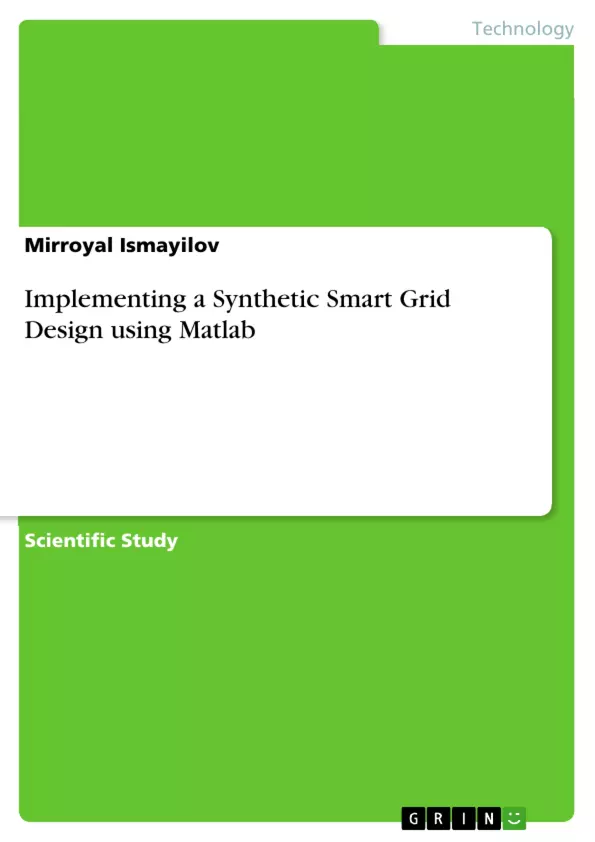In this practical work, a synthetic smart grid design is implemented by using Matlab. The specific focus is on the way the smart grid design problem has been turned into an optimization problem. Cost function is defined and minimized by the help of Global Optimization Toolbox, specifically, by the help of Genetic Algorithm within Matlab.
The Smart Grid represents an unprecedented opportunity to move the energy industry into a new era of reliability, availability, and efficiency that will contribute to our economic and environmental health. During the transition period, it will be critical to carry out testing, technology improvements, consumer education, development of standards and regulations, and information sharing between projects to ensure that the benefits we envision from the Smart Grid become a reality.
Inhaltsverzeichnis (Table of Contents)
- 1 Introduction
- 1.1 Smart Grid
- 1.2 Smart Grid Design with MATLAB
- 2 Selected Location and Load Profile
- 3 Renewable Energy Resources
- 3.1 The Wind Resource.
- 3.2 The Solar GHI Resource
- 4 Component Selection and Pricing
- 4.1 Photovoltaic Panel
- 4.2 Wind Turbine
- 4.3 Battery
- 4.4 Generator
- 5 Smart Grid Design
- 6 Optimization of Smart Grid
- 6.1 Optimization Algorithm
- 7 Optimization Results
- 8 Case Study Analysis
- 8.1 Energy Generated by Diesel Generator
- 8.2 CO2 Emissions
- 8.3 State of Charge
- 8.3.1 Curtail of Energy
- 8.4 Renewable Energy from PV panels
- 9 Conclusion
Zielsetzung und Themenschwerpunkte (Objectives and Key Themes)
This report aims to design a smart grid system for a rural African household, leveraging renewable energy sources like solar and wind power. The goal is to minimize reliance on traditional fossil fuel-based electricity generation, thereby reducing carbon emissions and promoting sustainable energy practices.
- Smart Grid Design and Implementation
- Renewable Energy Integration (Solar and Wind)
- Optimization Algorithms for Energy Management
- Case Study Analysis of a Rural African Household
- Assessment of Environmental Impact and Cost-Effectiveness
Zusammenfassung der Kapitel (Chapter Summaries)
- Chapter 1: Introduction This chapter provides an overview of smart grids and their potential benefits, highlighting the significance of integrating renewable energy sources. It also introduces the specific context of designing a smart grid using MATLAB for a rural African household.
- Chapter 2: Selected Location and Load Profile This chapter discusses the chosen location for the smart grid project, a rural African community in Botswana, and analyzes the typical load profiles of households in this region.
- Chapter 3: Renewable Energy Resources This chapter explores the availability of wind and solar energy resources at the selected location, providing essential data for the design of the renewable energy components of the smart grid.
- Chapter 4: Component Selection and Pricing This chapter delves into the selection of specific photovoltaic panels, wind turbines, batteries, and generators for the smart grid system, taking into account their technical specifications and cost considerations.
- Chapter 5: Smart Grid Design This chapter outlines the design of the complete smart grid system, integrating the chosen components and outlining their interconnection and functionality.
- Chapter 6: Optimization of Smart Grid This chapter focuses on the optimization algorithm employed to enhance the efficiency of the smart grid design, taking into account factors like load balancing, energy storage, and renewable energy utilization.
- Chapter 7: Optimization Results This chapter presents the results of the optimization process, showcasing the effectiveness of the chosen algorithm in optimizing the performance of the smart grid system.
- Chapter 8: Case Study Analysis This chapter analyzes the performance of the designed smart grid system based on real-world data, examining the energy generated by the diesel generator, CO2 emissions, state of charge of the battery, and the contribution of renewable energy sources.
Schlüsselwörter (Keywords)
The primary focus of this report revolves around smart grid design, renewable energy integration, optimization algorithms, and their application in a rural African household context. This includes terms like photovoltaic panels, wind turbines, battery storage, diesel generator, load profiles, carbon emissions, energy management, and case study analysis.
- Quote paper
- Mirroyal Ismayilov (Author), 2022, Implementing a Synthetic Smart Grid Design using Matlab, Munich, GRIN Verlag, https://www.hausarbeiten.de/document/1354250


